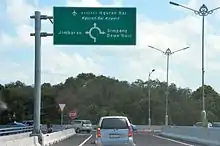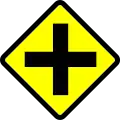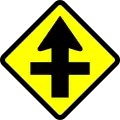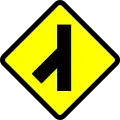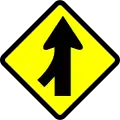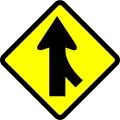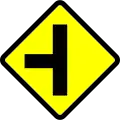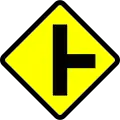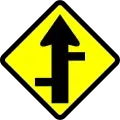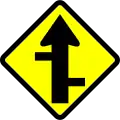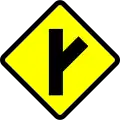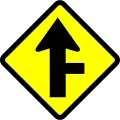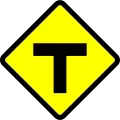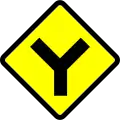Road signs in Indonesia
Road signs in Indonesia are standardized road signs similar to those used in other nations but with certain distinctions. As a former Dutch colony, until the 1970s road signs in Indonesia closely followed The Netherlands rules on road signs. Nowadays, Indonesian road sign design are a mix of European, US MUTCD, Australia, New Zealand and Japanese road sign features. According to the 2014 Minister of Transport's Regulation No. 13 concerning Traffic Signs,[1] the official typeface for road signs in Indonesia is Clearview. Indonesia formerly used FHWA Series fonts (Highway Gothic) as the designated typeface though the rules are not being implemented properly.
Indonesian road signs use Indonesian, the official and the national language of Indonesia. However, English is also used for important public places such as tourist attractions and airports. Bilingual signs can be found in tourist areas such as Bali.
Indonesia signed the Vienna Convention on Road Signs and Signals but have yet to ratify the Convention.
Warning signs
Warning signs warn of possible dangers or unusual conditions ahead and alert motorists on the hazards to expect. Warning signs in Indonesia used to closely follow US MUTCD and Japanese diamond-shaped with yellow background and black-and-yellow outline but recently they change it to full black outline.
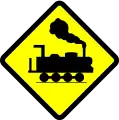 Open railroad crossing ahead
Open railroad crossing ahead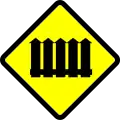 Railroad crossing ahead
Railroad crossing ahead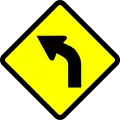 Curve
Curve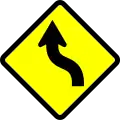 Double bend
Double bend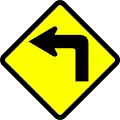 Sharp turn
Sharp turn Double sharp turns
Double sharp turns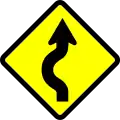 Succession of more than two bend
Succession of more than two bend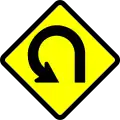 Degree loop
Degree loop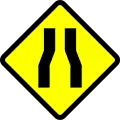 Road narrows
Road narrows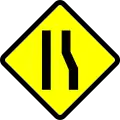 Road narrows on right
Road narrows on right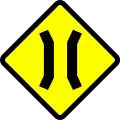 Narrow bridge
Narrow bridge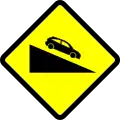 Steep descent
Steep descent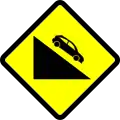 Hazardous descent
Hazardous descent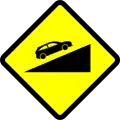 Steep ascent
Steep ascent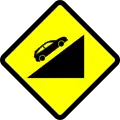 Hazardous ascent
Hazardous ascent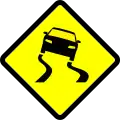 Slippery road
Slippery road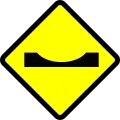 Dip
Dip Bump
Bump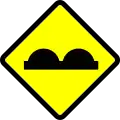 Bumpy road
Bumpy road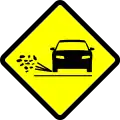 Loose gravel
Loose gravel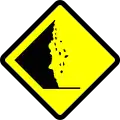 Falling rocks
Falling rocks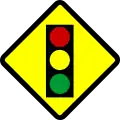 Traffic lights ahead
Traffic lights ahead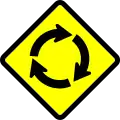 Traffic circle
Traffic circle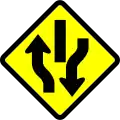 Start of dual carriageway
Start of dual carriageway End of dual carriageway
End of dual carriageway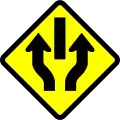 One way dual carriageway
One way dual carriageway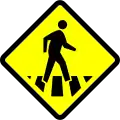 Pedestrian crossing
Pedestrian crossing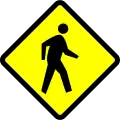 Pedestrian area
Pedestrian area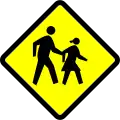 School crossing
School crossing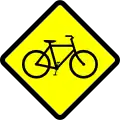 Bicycle zone
Bicycle zone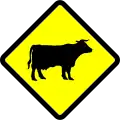 Farm animals crossing
Farm animals crossing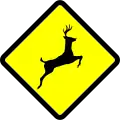 Wild animals crossing
Wild animals crossing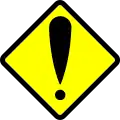 Other danger (usually followed with a supplementary sign beneath)
Other danger (usually followed with a supplementary sign beneath)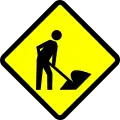 Roadworks ahead
Roadworks ahead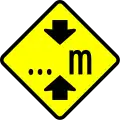 Max height limit
Max height limit_8d.svg.png.webp) Max width limit
Max width limit_8g.svg.png.webp) Low flying-aircraft
Low flying-aircraft_8h.svg.png.webp) Crosswinds
Crosswinds_8i.svg.png.webp) Two way-traffic
Two way-traffic_8j.svg.png.webp) Drawbridge
Drawbridge
Intersections
Regulatory signs
Prohibitory signs
Prohibitory signs in Indonesia are circular and have a red border with diagonal bars except for Stop, Yield, and Railroad Crossing signs.
_1a.svg.png.webp) Stop
Stop_1b.svg.png.webp) Yield
Yield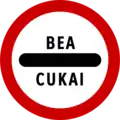 Custom post
Custom post_1c_(Gerbang_Tol).svg.png.webp) Toll plaza
Toll plaza One-track railroad crossing
One-track railroad crossing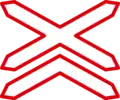 Multiple-track railroad crossing
Multiple-track railroad crossing_2a1.svg.png.webp) Do not enter for vehicles
Do not enter for vehicles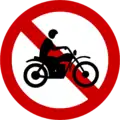 No motorcycles and mopeds
No motorcycles and mopeds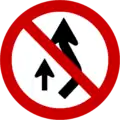 No passing
No passing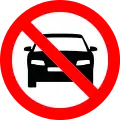 No cars
No cars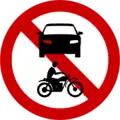 No vehicles (combination)
No vehicles (combination) No bicycles
No bicycles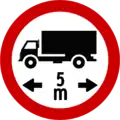 Maximum length for motorized vehicles
Maximum length for motorized vehicles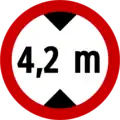 Maximum height limit
Maximum height limit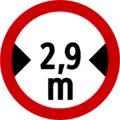 Maximum width limit
Maximum width limit Maximum weight limit
Maximum weight limit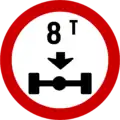 Maximum weight limit per axel
Maximum weight limit per axel_3a.svg.png.webp) No stopping
No stopping_3b.svg.png.webp) No parking
No parking_4b.svg.png.webp) No left turn
No left turn_4e.svg.png.webp) No U-turn
No U-turn_4f.svg.png.webp) No right turn or U-turn
No right turn or U-turn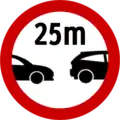 Minimum distance between cars
Minimum distance between cars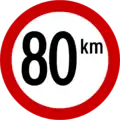 Maximum speed limit in kilometers per hour (km/h)
Maximum speed limit in kilometers per hour (km/h)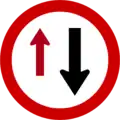 Yield to oncoming traffic
Yield to oncoming traffic_b11a_.svg.png.webp) End of speed restriction limit
End of speed restriction limit
Mandatory signs
Mandatory signs in Indonesia follows the "Type A Mandatory Signs" as prescribed by the Vienna Convention, which is the European-style white-on-blue circular signs with addition of white border
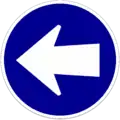 Follow left
Follow left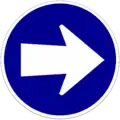 Follow right
Follow right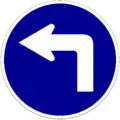 Turn left
Turn left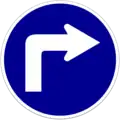 Turn right
Turn right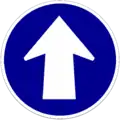 Go straight
Go straight Roundabout
Roundabout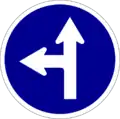 Straight ahead or left turn primited
Straight ahead or left turn primited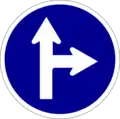 Straight ahead or right turn primited
Straight ahead or right turn primited_3a.svg.png.webp) Keep left
Keep left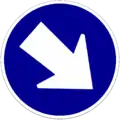 Keep right
Keep right_3c.svg.png.webp) Pass either side
Pass either side.svg.png.webp) Minimum speed limit in kilometres per hour (km/h)
Minimum speed limit in kilometres per hour (km/h)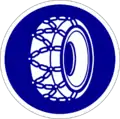 Tyre chain
Tyre chain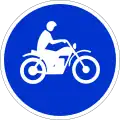 Motorcycles lane
Motorcycles lane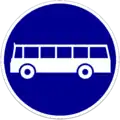 Bus-only lane
Bus-only lane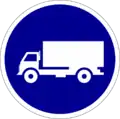 Truck-only lane
Truck-only lane_6b1.svg.png.webp) Pedestrians only
Pedestrians only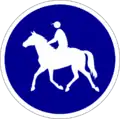 Equestrians only
Equestrians only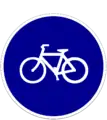 Bicycles only
Bicycles only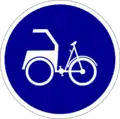 Rickshaws only
Rickshaws only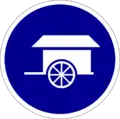 Carts only
Carts only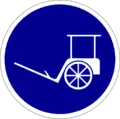 Horse carriage only
Horse carriage only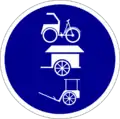 Non-motorized vehicles only
Non-motorized vehicles only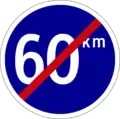 End of minimum speed limit
End of minimum speed limit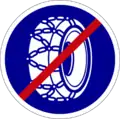 End of tyre chain usage
End of tyre chain usage
Directional signs
 4-way directional sign. Ngurah Rai International Airport is highlighted in blue as it is a public facility
4-way directional sign. Ngurah Rai International Airport is highlighted in blue as it is a public facility 3-way directional sign. Note the Indonesian National Highway number hexagon
3-way directional sign. Note the Indonesian National Highway number hexagon Exit to toll road
Exit to toll road National route distance sign (differs by island)
National route distance sign (differs by island) Entrance to toll road
Entrance to toll road 3-way directional sign. Kawasan Kota Tua, a tourist attraction, is highlighted in brown
3-way directional sign. Kawasan Kota Tua, a tourist attraction, is highlighted in brown 4-way intersection directional sign. TOL PURBALEUNYI, a motorway, is highlighted in white and bears the international highway symbol, while Stasiun KA Kota, a train station, is highlighted in blue.
4-way intersection directional sign. TOL PURBALEUNYI, a motorway, is highlighted in white and bears the international highway symbol, while Stasiun KA Kota, a train station, is highlighted in blue.
Freeway signs
Most of the signs in this section are custom-made by the toll road operator and unavailable in the current regulations.
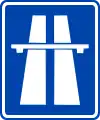 Freeway road
Freeway road Freeway begins
Freeway begins Freeway ends
Freeway ends Freeway restrictions for non-motorised vehicles ("Toll road is only for motorised vehicles with four or more wheels")
Freeway restrictions for non-motorised vehicles ("Toll road is only for motorised vehicles with four or more wheels") Toll plaza ahead
Toll plaza ahead Exit ahead (1 km)
Exit ahead (1 km) Exit ahead (500 m)
Exit ahead (500 m) Exit ahead (300 m)
Exit ahead (300 m) Exit sign (butterfly gantry sign placed in between ramp)
Exit sign (butterfly gantry sign placed in between ramp) Interchange ahead (1 km)
Interchange ahead (1 km) Interchange ahead (500m)
Interchange ahead (500m) Interchange ahead (300m)
Interchange ahead (300m) Interchange exit
Interchange exit Freeway distance sign
Freeway distance sign
 Motorway location marker with meters, placed in each 200 m of the Motorway
Motorway location marker with meters, placed in each 200 m of the Motorway Service area ahead (1 km)
Service area ahead (1 km) Service area ahead (500 m)
Service area ahead (500 m) Service area ahead (~300 m)
Service area ahead (~300 m) Bridge name
Bridge name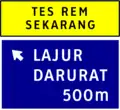 Runaway ramp. The 500m distance is omitted in 300m before the ramp
Runaway ramp. The 500m distance is omitted in 300m before the ramp Lane directory
Lane directory Advisory sign (Right lane for overtaking only)
Advisory sign (Right lane for overtaking only) Prohibition sign (Passing from left is prohibited)
Prohibition sign (Passing from left is prohibited) Distance guidance ahead [2]
Distance guidance ahead [2] Distance guidance (0m) [2]
Distance guidance (0m) [2] Distance guidance (50m-unsafe distance) [2]
Distance guidance (50m-unsafe distance) [2] Distance guidance (100m-safe distance) [2]
Distance guidance (100m-safe distance) [2] Toll plaza (pay toll)
Toll plaza (pay toll) Toll plaza (take ticket)
Toll plaza (take ticket) Toll plaza (electronic payment)
Toll plaza (electronic payment) Toll plaza height limit [3] (might be omitted in some toll plazas)
Toll plaza height limit [3] (might be omitted in some toll plazas) Warning sign (Fog)
Warning sign (Fog) Warning sign (Crosswind)
Warning sign (Crosswind)
Information signs
 City limits
City limits End of City limits
End of City limits Bus terminal
Bus terminal Train station
Train station Harbor
Harbor Airport
Airport Garbage/Waste disposal
Garbage/Waste disposal Landfil
Landfil Post office
Post office Telephone
Telephone Bus stop
Bus stop Taxi stand
Taxi stand Transit stop
Transit stop Crosswalk
Crosswalk Parking
Parking Disabled parking area
Disabled parking area Tunnel
Tunnel End of tunnel
End of tunnel Tsunami evacuation route
Tsunami evacuation route Earthquake evacuation route
Earthquake evacuation route Volcano eruption evacuation route
Volcano eruption evacuation route Emergency muster zone
Emergency muster zone Refuge camp
Refuge camp Refuge centre
Refuge centre Mosque
Mosque Church
Church Vihara
Vihara Hindu temple
Hindu temple Hospital
Hospital Clinic, Community Health Centre
Clinic, Community Health Centre Pharmacy
Pharmacy Petrol station
Petrol station Scheduled service station
Scheduled service station Emission service station
Emission service station Weight station
Weight station Museum
Museum Supermarket
Supermarket Restaurant
Restaurant Cafe
Cafe Hotel
Hotel Motor services
Motor services Park
Park Cross-country route
Cross-country route Tent camp
Tent camp Caravan camp
Caravan camp Camp
Camp vila
vila Beach
Beach Open sports field
Open sports field Indoor sports centre
Indoor sports centre Swimming pool
Swimming pool Stadium
Stadium School
School Library
Library One way
One way Dead end
Dead end U-turn permitted
U-turn permitted Motorized vehicles only
Motorized vehicles only
Temporary signs
Temporary signs generally follow New Zealand design, albeit with Clearview typeface instead of Highway Gothic typeface.
_1a.svg.png.webp) Curve left
Curve left_1b.svg.png.webp) Curve right
Curve right_1c.svg.png.webp) Road narrows
Road narrows_1d.svg.png.webp) Road widens
Road widens_1e.svg.png.webp) Narrow left
Narrow left_1f.svg.png.webp) Narrow right
Narrow right_1g.svg.png.webp) Widen left
Widen left_1h.svg.png.webp) Widen right
Widen right_1i.svg.png.webp) Lane ends on left
Lane ends on left_1j.svg.png.webp) Lane ends on right
Lane ends on right_1k.svg.png.webp) Added lane on left
Added lane on left_1l.svg.png.webp) Added lane on right
Added lane on right_1m.svg.png.webp) Narrow section
Narrow section_2a.svg.png.webp) Slippery road
Slippery road_2b.svg.png.webp) Uneven surface
Uneven surface_2c.svg.png.webp) Loose gravel
Loose gravel_3a.svg.png.webp) Diversion to the right
Diversion to the right_3b.svg.png.webp) Diversion to the left
Diversion to the left_3c.svg.png.webp) Diversion to the right ends
Diversion to the right ends_3d.svg.png.webp) Diversion to the left ends
Diversion to the left ends_3e.svg.png.webp) Traffic divided
Traffic divided_3f.svg.png.webp) Divided traffic ends
Divided traffic ends_3g.svg.png.webp) Traffic divided (two-way)
Traffic divided (two-way)_3h.svg.png.webp) Divided traffic ends (two-way)
Divided traffic ends (two-way)_4a.svg.png.webp) Warning signs (usually followed with a supplementary sign beneath)
Warning signs (usually followed with a supplementary sign beneath)_4b.svg.png.webp) Road workers
Road workers_4c.svg.png.webp) Maximum height
Maximum height_4d.svg.png.webp) Maximum width
Maximum width_4e.svg.png.webp) Two-way traffic
Two-way traffic_4f.svg.png.webp) Roadwork traffic controllers
Roadwork traffic controllers_Road_Work_Information.svg.png.webp) Worded warning sign (in this case "Road Work")
Worded warning sign (in this case "Road Work")
See also
References
- http://hubdat.dephub.go.id/km/tahun-2014/1626-peraturan-menteri-perhubungan-nomor-pm-13-tahun-2014-tentang-rambu-lalu-lintas/download
- Only found in the Jagorawi and the Jakarta-Serpong Motorway
- Indonesian vehicle maximum height standard, according to Article 54, Paragraph (1)c of the Indonesian Republic Government Regulation No. 55 of 2012 (shown in regulations as in millimetres, and height should not exceed 1.7 times vehicle breadth)
